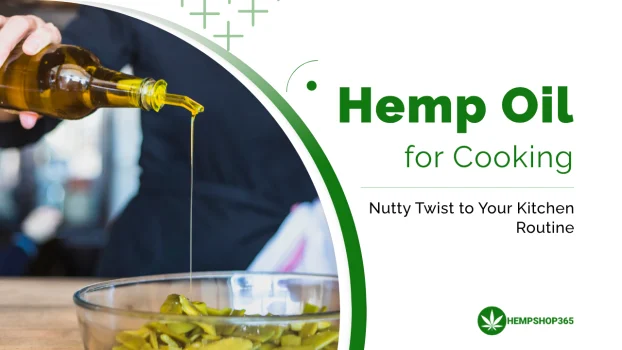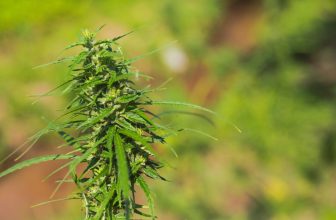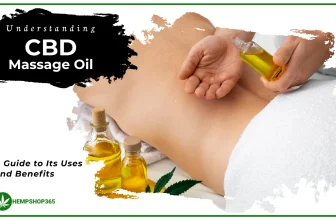Hemp oil, derived from the hemp plant (a cousin of cannabis), is gaining traction in kitchens worldwide. But is it just a fad, or does it offer real culinary benefits? Let’s explore the world of hemp oil for cooking and see how it can add a healthy and flavorful touch to your dishes.
Key Takeaways:
- Add depth and richness to dishes without overpowering them. Perfect for salads, dressings, and more!
- Packed with omega-3/6s, protein, and low in saturated fat – a healthy choice for everyone.
- Drizzle, dip, or blend! Use in dressings, marinades, or even smoothies for a nutty twist and health boost.
What is Hemp Oil?
Hemp seed oil, also known as hemp oil, is extracted from the seeds of the hemp plant. It’s important to note that this oil is distinct from CBD oil, which is derived from a different part of the plant and may have psychoactive effects. Hemp oil, on the other hand, contains no THC and is completely non-psychoactive.
Benefits of Using Hemp Oil for Cooking
- Rich in essential nutrients: Hemp oil boasts a unique nutritional profile, containing high levels of omega-3 and omega-6 fatty acids, essential for maintaining good heart health and brain function.
- Good source of protein: Compared to other plant-based oils, hemp oil offers a surprising amount of protein, making it a valuable addition for vegetarians and vegans.
- Low in saturated fat: Unlike many other cooking oils, hemp oil is low in saturated fat, making it a healthier choice for your heart.
- Unique nutty flavor: Hemp oil has a mild, nutty flavor that complements various dishes, adding a subtle richness without overpowering other ingredients.
How to Use Hemp Oil in Cooking
Important note: Hemp oil has a low smoke point, meaning it burns quickly at high temperatures. Therefore, it’s not suitable for frying or high-heat cooking. Here are some ways to use hemp oil in your kitchen:
- Salad dressings: Drizzle hemp oil over your salads for a nutty and nutritious boost. It pairs well with a variety of vegetables, cheeses, and fruits.
- Dipping sauces and marinades: Add a touch of hemp oil to your favorite dipping sauces and marinades for a unique flavor profile.
- Finishing oil: Drizzle hemp oil on cooked vegetables, fish, or pasta for a finishing touch and added richness.
- Smoothies and yogurt bowls: Add a spoonful of hemp oil to your smoothies or yogurt bowls for an extra dose of healthy fats and a subtle nutty flavor.
Remember: When purchasing hemp oil for cooking, look for cold-pressed and organic varieties to ensure maximum quality and freshness.
Some Popular Options for Hemp Oil for Cooking
Nutiva Organic Cold-Pressed Hemp Seed Oil: Certified USDA Organic and Non-GMO Project Verified, this hemp seed oil is a great all-around choice for cooking and baking. It has a mild, nutty flavor and is a good source of omega-3 and omega-6 fatty acids.
Carrington Farms Organic Hemp Seed Oil: Another USDA Organic certified option, Carrington Farm’s hemp seed oil is cold-pressed and expeller-pressed to preserve its nutrients and flavor. It’s a good source of essential fatty acids and has a slightly nutty taste.
Good Hemp The Original Hempseed Cooking Oil: This hemp oil for cooking is 100% natural and rich in omega-3 fatty acids. It has a light, nutty flavor that works well in various dishes.
Barlean’s Organic Hemp Seed Oil: This brand offers a variety of hemp seed oil products, including flavored options like garlic and chilli lime. Their oils are USDA Organic certified and cold-pressed to preserve freshness.
Manitoba Harvest Hemp Hearts Hemp Seed Oil: This hemp oil for cooking comes from the popular brand Manitoba Harvest. It’s cold-pressed and unrefined, offering a rich source of omega-3 and omega-6 fatty acids.
Conclusion:
Hemp oil for cooking is a versatile and healthy addition to your kitchen. With its unique flavor and impressive nutritional profile, it can elevate your dishes while providing essential nutrients. So, next time you’re looking for a new and exciting ingredient to explore, consider giving hemp oil a try!








